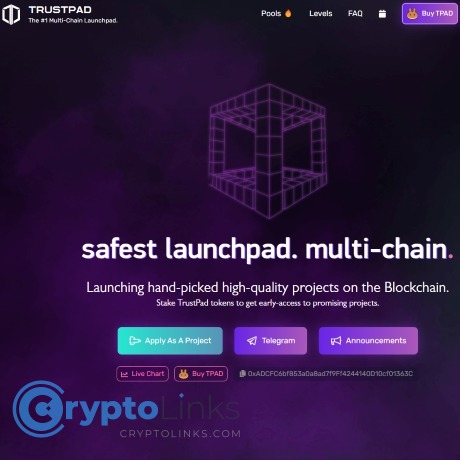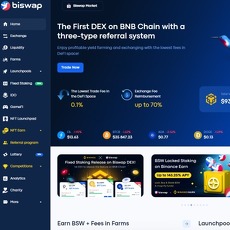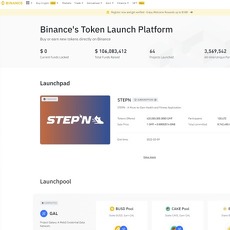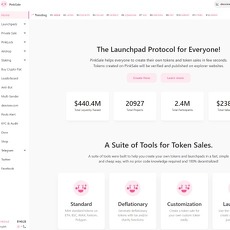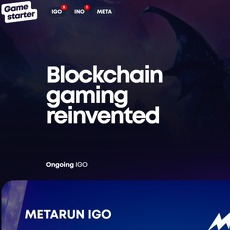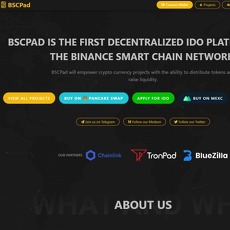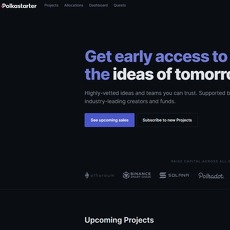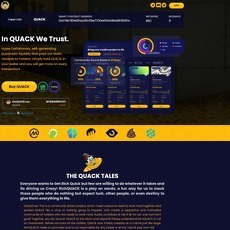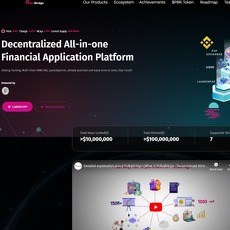TrustPad Review
TrustPad
trustpad.io
Trustpad.io Review: Everything You Need to Know (FAQ Included)
Imagine getting the chance to back cutting-edge blockchain projects before they become the next big thing in the crypto world. Sounds exciting, doesn’t it? But where do you even begin? How do you know you're not just throwing funds into a scam? This is where platforms like Trustpad.io step in to fill the gap.
Whether you're an investor looking for promising opportunities or a developer struggling to secure funding for your project, the crypto space can feel incredibly risky. With scams on one side and a lack of reliable funding on the other, both parties face a constant uphill battle. So, what’s the solution?
The Problem: Why Investors and Projects Need Platforms Like Trustpad.io
If you’ve ever tried to invest in an early-stage project, you know how much of a gamble it can be. You’re not just trying to analyze whether the idea is good—half the time, you’re busy wondering if there’s a team behind it or if the whole thing will vanish overnight. It’s a high-stakes game many retail investors hesitate to play—and for good reason.
On the flip side, legitimate blockchain developers face an equally tough challenge. They’ve got a brilliant idea and the technical know-how to pull it off, but finding genuine investors can feel next to impossible. Add fake promises, shoddy funding models, and constant fear of exploitation into the mix, and you can see why the crypto funding space often looks like chaos.
The Promise: How Trustpad.io Changes the Game
This is where Trustpad.io steps into the scene, claiming to bring trust and structure to a notoriously unreliable space. The platform says it offers a secure way for investors to support early-stage blockchain projects, while giving those projects a safe, structured environment to raise funds.
Think of it as a bridge—a way to connect visionaries with opportunities and make every step as secure and transparent as possible. But the question is, does it deliver?
What We’ll Cover in This Article
This is just the start, but there’s a lot more ground to cover in this Trustpad.io review. Here’s a little taste of what’s coming next:
- What exactly is Trustpad.io, and who is it built for?
- The key features that make it stand out in the crowded crypto space.
- Your burning questions about its legitimacy, usability, and more—answered.
- Step-by-step guidance on how to safely get started on the platform.
It’s easy to get excited, but before we go any further, let’s address the elephant in the room: What is Trustpad.io, and why does it matter to investors and developers alike? Keep reading—we’ll break it all down in the next section.
What is Trustpad.io?
So, what’s all the buzz about Trustpad.io? Why does it seem like everyone in the crypto world is talking about it? Imagine this—a platform designed to give investors a way to safely hop on early blockchain projects while helping those projects get the funds they desperately need to grow. That’s exactly where Trustpad.io fits in. Let’s break it down so it all makes sense, even if you’re new to this space.
A Launchpad Built for Security
Trustpad.io calls itself a decentralized multi-chain fundraising platform, and the keyword here is "security." It's one of those rare places in the crypto world where security isn’t just a slogan. The platform uses blockchain and smart contracts to ensure that both investors and project owners are protected every step of the way. Think about it—how many times have we heard horror stories of scams or rug pulls? Trustpad.io aims to flip the script.
Here’s the beauty of their approach: projects are rigorously vetted before they even make it to the platform. What does that mean for you as an investor? Peace of mind. It’s not 100% foolproof (nothing in crypto is), but they go the extra mile to protect their users.
"Trust isn't given, it's earned—and in crypto, it's built through transparency."
That’s why Trustpad.io is attracting attention; it’s trying to rewrite the trust game in crypto investing.
Target Audience: Who’s It For?
Here’s the deal: Trustpad.io isn’t for everyone, but it nails it for specific groups. Are you in one of these categories?
- Investors: This could be you if you're actively searching for fresh blockchain projects to pour your funds into, hoping to discover the next big thing before everyone else.
- Developers or startups: Got a killer idea but can't get funding? Trustpad.io promises to connect you with a keen audience looking to support promising ventures.
Basically, whether you want to grow your wallet as an investor or bring your dream crypto project to life, this platform might have what you're looking for.
How Blockchain Powers the Platform
If you’re wondering why blockchain matters here, stop and think for a second about what makes crypto awesome in the first place. Transparency and automation. Trustpad.io uses those strengths to build trust between you and the projects listed on its platform.
Here’s how it works:
- Smart Contracts: Everything is automated and out in the open. These contracts essentially execute agreements without needing intermediaries. For you, that means fewer human errors—and fewer shady dealings.
- Immutable Records: Blockchain tech ensures that every little transaction detail is recorded and can’t be tampered with. What you see is what happened. Period.
The coolest part? Trustpad.io supports multiple blockchain networks, expanding your options as both an investor and a project owner. But how does that process work? Stick around because we’ll be breaking it all down in the next section (you’re going to want to know!).
How Does Trustpad.io Work?
Let’s get down to what you’re here for—how does Trustpad.io actually work? It's one thing to hear about “secure fundraising” or “early access to projects,” but how do you, the user, actually engage with the platform? Don’t worry; I’ve got you covered with straightforward insights.
The Investment Process
Ever wondered how people end up buying into those early-stage projects that skyrocket later? Trustpad.io simplifies that for you. Here’s the step-by-step process:
- Step 1: Browse Active Projects: You’ll first explore a curated list of blockchain-based projects currently seeking funding. Trustpad showcases project details, including their goals, tokenomics, and timelines, so you have all the critical info before making a move.
- Step 2: Verify Your Eligibility: Based on your staked $TPAD tokens (we’ll get to $TPAD in a second), you’ll see what tiers of investment opportunities are available for your level.
- Step 3: Commit Your Funds: Once you’ve found a project you believe in, you simply commit your funds via the platform’s secure smart contract system. Your investment is locked safely until the project’s token launch or defined goals are met.
- Step 4: Access Your Tokens: After the fundraising is complete and the project goes live, you’ll get your share of the project tokens according to your level of contribution.
It’s efficient, easy to follow, and most importantly, structured in a way that protects you. With some competitors, this process feels like a gamble. With Trustpad.io, you’re stepping into vetted opportunities with transparency baked into every step.
Multi-Chain Support
Here’s a dealbreaker feature for many crypto investors—multi-chain support. Most launchpads stick to just one blockchain, but Trustpad.io removes these limitations. Whether you’re into Binance Smart Chain (BSC), Ethereum, Polygon, or others, this platform allows projects from various chains to reach investors. And guess what? That opens the door to more opportunities for you.
Think about it: if you’re only playing on Ethereum, you’re missing out on the booming ecosystems from other chains. Multi-chain compatibility ensures you’re not boxed into one blockchain universe. According to a report by Chainalysis, cross-chain solutions are the future of DeFi. Trustpad.io is already ahead of the curve by implementing this feature seamlessly.
Staking $TPAD
What’s $TPAD, and why does it matter? In the Trustpad ecosystem, $TPAD is the native token—or the key that unlocks the door to bigger opportunities.
Here’s the gist:
- By staking $TPAD, you secure a spot in the investment tiers, giving you access to exclusive early-stage projects.
- The more $TPAD you stake, the higher your tier. Higher tiers open the door to better allocation of tokens in premium projects.
- Besides access, staking also provides rewards, including staking yield—which is essentially interest you earn over time.
Imagine this: You’re staking $TPAD, which helps you maintain your position while passively raking in rewards. Then, one day, you invest in a project that turns into the next Axie Infinity. That feeling? It’s what keeps people staking tokens like $TPAD and watching their portfolios grow.
“Opportunity doesn’t knock twice, but sometimes it knocks early. Staking on Trustpad.io ensures you’re there to answer.”
Staking isn’t just about locking up value; it’s about becoming an integral part of this ecosystem. People often overlook the power of community tokens, but through $TPAD staking, you align yourself with the future growth of the platform itself. If you’ve been waiting to get into exclusive IDOs (Initial DEX Offerings) but were always late to the party, staking changes that game entirely.
Curious about what makes Trustpad.io a cut above the rest? Wondering how this platform vets projects so strictly while still staying decentralized? Trust me, what’s coming next is something you don’t want to miss. Let’s take a closer look at the features that define why Trustpad.io truly stands out. Could they be the key to finding your next 10x project?
Key Features That Make Trustpad.io Worth Considering
If you're looking for a platform that takes your crypto investments seriously while offering a transparent and secure experience, Trustpad.io has some standout features you shouldn’t miss. Here’s exactly why it’s creating such a buzz, and how these features could make a difference to your journey in the risky but rewarding world of crypto.
Tiered System for Investors
Ever felt like your investment level limits your access to opportunities? Trustpad.io flips the script with its tiered system. This structure doesn’t just open the door to everyone—it tailors opportunities based on your level of commitment to the platform.
- Higher tiers unlock early access: If you stake more $TPAD tokens, you move up the tier ladder, giving you priority access to the most promising projects.
- Access for smaller investors too: Don’t worry if you’re just getting started. Lower tiers are available, so even with a modest contribution, you can still participate.
Imagine securing a spot in a game-changing project just because you chose the right tier—this is big in a competitive space like blockchain. It feels a bit like getting first-class perks even when others are still boarding the flight!
High-Quality Vetting Process
Let’s be honest here. The crypto world can sometimes feel like a minefield. You don’t want to trip over a scam project pretending to be the “next big thing.” Trustpad.io’s vetting process aims to change that entirely by ensuring only legitimate and well-thought-out projects make it to the platform.
The team at Trustpad.io screens projects thoroughly, examining areas like:
- The project’s track record and background research
- The team’s authenticity and expertise
- Potential use case and market demand
This offers a layer of trust that many other platforms just can’t match. And this isn’t just hearsay—a recent blockchain analysis report revealed that 86% of successful crypto projects in 2022 focused on transparency and team credibility from the start. This vetting process aligns Trustpad.io with this trend, ensuring it filters out the noise for its users.
Decentralized Approach
Here’s where Trustpad.io really aligns with the heart of blockchain technology. It takes a fully decentralized approach to operations. But why does this matter for you?
- Your funds, your rules: Unlike centralized platforms, Trustpad doesn’t hold or control your funds. Using smart contracts, everything operates transparently, reducing the risk of misuse.
- No middlemen drama: Decisions are powered by the community, not a small, centralized team. This means users like you have a say in how things operate.
“Decentralization is not just a technical term; it’s about putting power back into the hands of the community.”
It’s this community-first design that has won the favor of so many crypto enthusiasts. If you’re tired of feeling like a nameless user on huge platforms, this feature will probably resonate with you.
More Features You’ll Love
Trustpad.io brings a few more goodies to the table that are worth mentioning. These features might not take the front seat, but they add up to a much smoother experience overall:
- Anti-rug mechanisms: Built into the platform, these systems provide additional protection against rug pulls, so you get some peace of mind when investing.
- User-friendly interface: Whether you’re new or experienced in crypto, navigating Trustpad feels natural and hassle-free. Accessing projects, staking, or interacting with tools doesn’t require any steep learning curve.
- Cross-chain compatibility: Supporting multiple chains like Binance Smart Chain, Ethereum, and others, Trustpad.io expands the possibilities for both projects and investors. You’re not limited to a single network.
These thoughtful touches are designed to give everyone—whether developer or investor—the confidence to get involved without a massive risk.
After learning about these features, you might be wondering: “Does Trustpad.io do it all perfectly, or are there any gaps?” Stick around, because up next, I’ll take an honest look at the pros and cons of this platform. Let’s see if Trustpad really hits all the right notes or has areas that could use some fine-tuning.
Pros and Cons of Trustpad.io
Nothing is perfect in the world of crypto platforms, and Trustpad.io is no exception. But that's not necessarily a bad thing—it gives us a clear view of what works well and where it might need some tweaking. Let's unpack the real wins and the areas that could use a little boost.
Trustpad Positives
Let’s start with the good stuff, the features that make Trustpad.io worth giving a shot:
- Security You Can Count On: One of Trustpad’s standout features is how safe it makes early investing feel. With its advanced vetting process, you’re less likely to encounter rug pulls or scams. It’s the kind of barrier crypto investors have been longing for.
- Access to Early-Stage Opportunities: Let’s face it—finding the “next big thing” in crypto can sometimes feel like looking for a needle in a haystack. Trustpad.io offers a platform where you can get in early, potentially catching projects before they skyrocket.
- Multi-Chain Powers Your Investments: Not all launchpads open their doors to multiple blockchains, but Trustpad does. Whether you’re into Ethereum, Binance Smart Chain, or others, this multi-chain approach means you’re not stuck in one ecosystem.
- Community-Oriented: The tier system seems designed to give back to users who engage and participate more. Higher engagement means better access, a model that rewards active investors.
It’s clear why Trustpad has earned a lot of trust from its community. It tackles a known crypto problem (a lack of safety) with better solutions. But like anything, there’s room to grow.
Where It Can Improve
Now, let’s look at the parts that could make you pause or hold back. While Trustpad has a lot going for it, there are a few limitations:
- High Staking Requirements: To unlock the full potential of the platform—like participating in higher-tier projects—you’ll need to stake their native $TPAD tokens. For some, this entry price could feel like a roadblock.
- Not Fully Worldwide Yet: Depending on where you’re located, you might face restrictions. While crypto tends to go global, regulatory challenges could limit platform accessibility in certain regions.
- Competition in the Launchpad Space: The crypto world now has dozens of launchpads. Trustpad competes with some heavy hitters, which means users may compare features, fees, and ease of use more critically.
Here’s a quote I heard that stuck with me: "Every strength can become a weakness when pushed too far." The high staking requirement, for example, might protect the quality of the community, but it also creates barriers for smaller investors looking to test the waters. It’s a balancing act.
So, how do you decide if this is the platform for you? Well, maybe the answer lies in the questions you’re already asking yourself...
Hungry for answers?
Wondering if staking is the only way in? Or whether the platform’s vetting process is bulletproof enough to squish all your fears? Don’t stop reading now—we’ll explore these and other burning questions. Let’s make sure you go into Trustpad.io fully prepared.
FAQ Section: Your Burning Questions Answered
Got questions swirling around in your head about Trustpad.io? You’re not alone. Let’s get straight to the point and tackle some of the top questions people like you are asking. Whether it's about legitimacy or how to get started, I’ll break it down for you in the simplest way possible. So, stick with me—you might just find the exact answers you’ve been searching for.
Is Trustpad.io Legit?
This is the first thing people want to know. And let’s be real: the crypto world isn't exactly sunshine and rainbows; scams have left people scarred. So, can you trust Trustpad.io?
Here’s the good news: Trustpad.io operates transparently, with verified partnerships and fully functioning smart contracts. Most importantly, projects on the platform go through a rigorous vetting process before launch to weed out the shady ones. There’s also the added comfort of blockchain-powered security, which minimizes the risk of manipulation or fraud.
One user recently pointed out, “If a launchpad goes the extra mile to protect investors while enabling legit projects to thrive, that’s a platform worth exploring.” And honestly, that’s where Trustpad shines. So, yes, Trustpad shows strong signs of being a legitimate platform—but remember, in crypto, always do your due diligence.
How Do I Start Using Trustpad.io?
Thinking about jumping in? The process is incredibly user-friendly. Whether you're an investor brimming with FOMO or a project developer looking to kickstart funding, the platform has you covered.
To begin:
- Create an account: This step is simple and secure. Just visit Trustpad.io, sign up, and follow the prompts.
- Explore projects: Once you're set up, browse the available investment opportunities tailored to your risk appetite and interests.
- Get started with staking: If required, staking Trustpad’s token ($TPAD) might give you access to more perks (explained further below).
If you’ve done any trading on crypto exchanges, navigating Trustpad.io will feel like second nature. Haven’t traded before? No worries—the platform keeps it fairly hassle-free.
Do I Need to Stake Tokens to Participate?
Short answer: Yes, but let me explain why it’s worth it.
Staking $TPAD tokens unlocks your ability to participate in early-stage projects depending on your tier level. In simple terms, the more tokens you stake, the more access and opportunities you get. From a psychological angle, this also introduces a sense of exclusivity—you're not just anyone; you're someone with skin in the game.
Beyond just getting access, staking also signals your commitment to the ecosystem, which is why Trustpad rewards participants with added benefits such as higher allocation limits and early notifications for upcoming projects.
What Blockchain Networks Does It Support?
Here’s where Trustpad flexes its multi-chain muscles. Unlike platforms that are tied to just one chain, Trustpad supports a variety of them:
- Ethereum (ETH)
- Binance Smart Chain (BSC)
- Polygon (MATIC)
- Fantom (FTM)
- Solana (SOL)
- And others emerging in the space
This multi-chain feature is golden because it lets you choose projects from different ecosystems, depending on what you trust, prefer, or see as profitable. Think of it as a buffet—why pick one dish when you can sample many?
If you're unsure which blockchain is the best for you, no stress. It’s all about exploring projects that align with your goals.
“Knowledge is power, but knowing where to start gives you the edge.”
And speaking of getting started, the next step is diving into the “how” of onboarding. Curious about what tools you’ll need or how to score your first project? Let’s keep this train rolling—your answers are right around the corner.
How to Get Started with Trustpad.io
Starting anything new in crypto can feel a bit overwhelming, but trust me when I say that getting started with Trustpad.io is much simpler than it sounds. Whether you're someone who's already dipped their toes into crypto or you're just stepping into the world of decentralized investments, this platform makes the process straightforward. I’ll break it down for you step by step right here.
Setting Up an Account
First things first—you need an account. But unlike traditional finance platforms, you don’t really need to go through lengthy KYC (Know Your Customer) verifications. Here’s how you can set one up in just a few minutes:
- Step 1: Navigate to Trustpad.io. On the top-right corner, you’ll spot a "Connect Wallet" button. Click on it.
- Step 2: Choose your preferred wallet from the options provided. Popular ones like MetaMask or Trust Wallet will work seamlessly. Don’t have a crypto wallet? You might want to set up MetaMask first—hundreds of tutorials are one Google search away.
- Step 3: Grant the necessary permissions to link your wallet to Trustpad.io. This step is crucial since your wallet essentially becomes your account. No usernames, no passwords, just your wallet address.
That’s it—you’re ready to explore what the platform offers!
Funding Your Wallet
Before jumping into any project, you’ll need to fund your wallet. After all, you can’t nab those early-stage investments without some crypto in hand. Here’s how to do it efficiently:
- Step 1: Ensure your wallet is on a blockchain network supported by Trustpad.io. Common ones include Binance Smart Chain (BSC), Ethereum, or others—it’ll depend on which projects interest you.
- Step 2: Transfer crypto into your wallet. For example, if you’re using Binance Smart Chain, you’ll likely need $BNB (Binance Coin) for gas fees and $TPAD tokens for staking or participation.
- Pro Tip: Always keep a small reserve of native blockchain tokens (like $ETH for Ethereum or $BNB for BSC). Gas fees can sneak up on you, and the last thing you want while securing a hot project is insufficient funds for transaction fees.
If all this sounds a little tech-heavy, don’t overthink it—it’s just like topping up a prepaid card. Just triple-check wallet addresses and verify amounts before sending; there are no do-overs in crypto transactions.
Joining a Project
Here’s where things get exciting—you’re now ready to secure your spot in early-stage blockchain projects. Think about it—this could be your chance to fund the next big thing in the crypto world. Here’s how you make that happen:
- Step 1: Browse active and upcoming projects on Trustpad.io’s platform. Each project usually has a detailed page including its roadmap, funding target, and other essential details—go through those carefully. Ask yourself: Does this project make sense to me? Does it feel legit?
- Step 2: Staking may be required to participate in certain projects depending on their tier system. Stake enough $TPAD tokens if needed—it unlocks your participation eligibility.
- Step 3: Once a project goes live, allocate your funds to it through the platform. This is done directly via your connected wallet, keeping things safe and transparent thanks to blockchain technology.
- Step 4: Track your investment. Trustpad usually provides updates on project milestones and token distribution. Keep your wallet handy since your tokens will likely arrive there after the sale ends.
During the process, always prioritize security. Scammers love blockchain too, and it’s crucial to avoid phishing attempts by accessing the platform through official links only. Bookmark Trustpad.io to keep things simple and safe.
"Success in crypto is about being curious, but not careless. The right platform can turn curiosity into opportunity—if you understand how to use it."
Does this feel like a lot? It’s really not. You’re essentially creating an account, funding it, and choosing which projects to invest in—three steps that could potentially open the door to major opportunities.
But let me ask you: How do you make sure the projects you choose are the cream of the crop? When you’re ready to move beyond just making an account, make sure you check out some trusted resources too. Because knowing where to look next is just as crucial—so how about we explore what's out there?
Other Essential Resources Worth Checking Out
If you're using Trustpad.io—or even just considering it—you might be wondering, "What else can I explore to learn even more or find other exciting opportunities?" You’re in the right place because there are a ton of valuable resources that can guide your crypto journey. Here’s a mix of helpful tools, platforms, and communities that every savvy crypto investor should have in their toolkit.
Cryptolinks.com Project Listings
Why limit yourself to just one launchpad? If you want to explore more groundbreaking projects beyond Trustpad, Cryptolinks' Project Listings is a treasure trove of options. What’s cool about this resource is how it curates a variety of crypto opportunities from different platforms, saving you the headache of searching everywhere. Think of it as your shortcut to discovering the next big thing in blockchain.
For example, let’s say you’ve just participated in a Trustpad round, but you're hungry for more. Head over to Cryptolinks and you’ll find hand-picked platforms and projects with detailed descriptions. Whether you’re into utility tokens, DeFi, or NFTs, there’s something there for all your interests.
Tutorials and Community Resources
Crypto can seem overwhelming at times, especially when you’re juggling multiple platforms or trying to wrap your head around staking mechanics and blockchain networks. That’s where community-driven resources and tutorials come in handy. They act as your personal guide through the complex world of crypto.
For tutorials, check out YouTube channels like DataDash or forums like BitcoinTalk, where thousands of enthusiasts share tips, tricks, and insights. If you’re looking for a more focused community with blockchain developers, I highly recommend checking out Telegram groups or Reddit forums such as r/CryptoCurrency.
You’ll often find insider advice or even lesser-known opportunities being discussed, which could be your next jackpot.
Why You Should Bookmark Resources
Think about this—every serious investor or crypto enthusiast I know has one thing in common: they always keep their go-to resources close by. Whether it’s for market updates or understanding new investment tools, having the right links at your fingertips saves time, effort, and prevents silly mistakes. And when platforms like Trustpad.io keep rolling out updates or new partnerships, staying informed means you’re ahead of the game.
Quick note: If you’re newer to crypto investment, don’t just rely on one platform, no matter how secure it seems. Diversifying not only minimizes risk but also helps you identify patterns and trends across the industry. That makes you smarter, faster, and dare I say, wealthier.
So, What’s Next?
With all these tools we’ve talked about, are you feeling ready to jump deeper into the world of cryptocurrency launchpads, or do you still have doubts? Maybe you’re wondering: Is Trustpad.io the best option for you, and how does it stack up against its competitors? Stick around because we’re about to tackle that head-on in the next section. Trust me, you’ll want to see the final verdict. Or better yet—what’s your favorite crypto resource and why?
Final Thoughts: Should You Trust Trustpad.io?
We’ve covered a lot about Trustpad.io, so now it’s time for the big question: Is it worth your trust, time, and money? As someone who’s seen countless platforms in the crypto space, here are my honest thoughts about why Trustpad.io might or might not be your go-to launchpad.
The Key Takeaways
Let’s break it down. Here are the most vital points about Trustpad.io:
- Security-first approach: Trustpad.io has built its reputation on prioritizing investor safety with robust vetting processes and smart contract transparency.
- Multi-chain support: This feature can’t be underestimated. Being able to access opportunities across multiple blockchain ecosystems, all from one platform, is a huge plus in today’s fragmented crypto landscape.
- Tiered system for fairness: The platform’s tier system allows investors with different staking levels to have fair access to opportunities, promoting inclusivity and avoiding whale dominance.
These points alone make Trustpad.io stand out compared to many other launchpads in the market. But like any platform, it’s not all perfect.
My Honest Opinion
If I had to sum it up, I’d say Trustpad.io operates with a solid balance of opportunity and caution. For investors, the chance to be part of budding projects before they hit the mainstream is tempting—who doesn’t want to get in early on a potential moonshot? That said, the risks in the crypto space are very real, and no platform, Trustpad.io included, can guarantee absolute safety.
What I admire most is their vetting process. Plenty of investors (myself included) have been burned by shady projects in the past. Trustpad.io makes an effort to identify and promote legitimate startups, and that’s no small thing. Still, it’s crucial to do your own research (DYOR) before making any commitments. Even a well-vetted project could underperform—it’s the nature of crypto.
Now, let’s address one pain point: staking requirements for platform access. While staking $TPAD tokens unlocks features and ensures fairness through the tier system, the upfront cost might be a hurdle for smaller investors. For some, this could limit participation, and it’s something Trustpad.io could tweak to improve accessibility.
The decentralized aspect is another reason I think Trustpad.io holds potential. The idea of taking the power out of centralized authorities’ hands aligns with blockchain’s core ethos. So if decentralization matters to you, this is worth paying attention to.
Closing Questions: What Do You Think?
Ultimately, my goal is to share a balanced view and let you make the call. Trustpad.io introduces a unique, security-focused take on crypto investments, and it might just be what you’re looking for if you’re into early-stage projects.
Now it’s your turn—what’s your verdict? Have you tried Trustpad.io yourself, or are you sitting on the fence waiting for the right project? I’d love to hear your thoughts. Drop your questions, opinions, or even your own experiences in the comments below. Let’s keep the conversation going.
Crypto isn’t just about profits—it’s a journey where we all learn and grow together. If Trustpad.io becomes your choice for that journey, approach it with knowledge, caution, and a dash of optimism.
For the most comprehensive, up-to-date list of vetted mining pools—complete with profitability calculators and hardware recommendations—visit CryptoLinks.com. We've done the heavy lifting so you can mine smarter!

